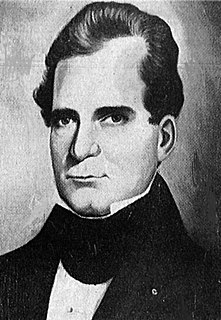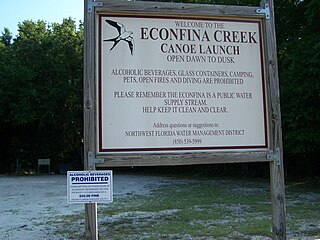
Jackson County is a county located in the U.S. state of Florida, on its northwestern border with Alabama. As of the 2020 census, the population was 48,889. Its county seat is Marianna.

Brooks County is a county located in the U.S. state of Georgia, on its southern border with Florida. As of the 2010 census, the population was 16,243. The county seat is Quitman. The county was created in 1858 from portions of Lowndes and Thomas counties by an act of the Georgia General Assembly and was named for pro-slavery U.S. Representative Preston Brooks after he severely beat abolitionist Senator Charles Sumner with a cane for delivering a speech that upset him.

Slavery in the United States was the legal institution of human chattel slavery, comprising the enslavement primarily of Africans and African Americans, that existed in the United States of America from its founding in 1776 until the passage of the Thirteenth Amendment in 1865. Slavery was established throughout European colonization in the Americas. From early colonial days, it was practiced in Britain's colonies, including the Thirteen Colonies which formed the United States. Under the law, an enslaved person was treated as property and could be bought, sold, or given away. Slavery lasted in about half of U.S. states until 1865. As an economic system, slavery was largely replaced by sharecropping and convict leasing.

Two-Seed-in-the-Spirit Predestinarian Baptists are part of a larger sub-group of Baptists that is commonly referred to as "anti-mission" Baptists. This sub-group includes the Duck River and Kindred Baptists, Old Regular Baptists, some Regular Baptists and some United Baptists. Only a minuscule minority of Primitive Baptists adhere to the Two-Seed doctrine. The primary centers of Two-Seedism were in Northern Alabama, Arkansas, Eastern Tennessee, Florida, Georgia, Illinois, Indiana, and Texas. As of 2002, five churches or congregations of this faith and order still existed in Alabama, Indiana, Tennessee, and Texas.

Amelia Island is a part of the Sea Islands chain that stretches along the East Coast of the United States from South Carolina to Florida; it is the southernmost of the Sea Islands, and the northernmost of the barrier islands on Florida's Atlantic coast. Lying in Nassau County, Florida, it is 13 miles (21 km) long and approximately 4 miles (6.4 km) wide at its widest point. The communities of Fernandina Beach, Amelia City, and American Beach are located on the island.

The history of the colonial period of South Carolina focuses on the English colonization that created one of the original Thirteen Colonies. Major settlement began after 1651 as the northern half of the British colony of Carolina attracted frontiersmen from Pennsylvania and Virginia, while the southern parts were populated by wealthy English people who set up large plantations dependent on slave labor, for the cultivation of cotton, rice, and indigo.

William McIntosh, also known as Tustunnuggee Hutke, was one of the most prominent chiefs of the Creek Nation between the turn of the nineteenth century and his execution in 1825. He was a chief of Coweta town and commander of a mounted police force. He became a planter who owned slaves, an inn, and a ferry business.

Partus sequitur ventrem was a legal doctrine passed in colonial Virginia in 1662 and other English crown colonies in the Americas which defined the legal status of children born there; the doctrine mandated that all children would inherit the legal status of their mothers. As such, children of enslaved women would be born into slavery. The legal doctrine of partus sequitur ventrem was derived from Roman civil law, specifically the portions concerning slavery and personal property (chattels).
A plantation house is the main house of a plantation, often a substantial farmhouse, which often serves as a symbol for the plantation as a whole. Plantation houses in the Southern United States and in other areas are known as quite grand and expensive architectural works today, though most were more utilitarian, working farmhouses.
The plantations of Leon County were numerous and vast. Leon County, in the U.S. state of Florida, was a true cotton kingdom. From the 1820s through 1850s Leon County attracted cotton planters from Georgia, Virginia, Maryland, North and South Carolina, plus other states and abroad to its fertile red clay soils and long growing season.

John E. Coffee was a military leader and a Congressman for the state of Georgia.

Johnson Hagood was a planter, soldier and military officer in the Confederate States Army during the American Civil War, reaching the rank of Brigadier General in the state militia and regular Confederate Army in 1862.

The Upland South or Upper South is a cultural and geographic subregion in the inland part of the Southern and lower Midwestern states. It differs from the Deep South and Atlantic coastal plain areas in terms of terrain, histories, economics, demographics, and settlement patterns.

The history of slavery in Kentucky dates from the earliest permanent European settlements in the state, until the end of the Civil War. Kentucky was classified as the Upper South or a border state, and enslaved African Americans represented 24% by 1830, but declined to 19.5% by 1860 on the eve of the Civil War. The majority of enslaved people in Kentucky were concentrated in the cities of Louisville and Lexington, in the fertile Bluegrass Region as well the Jackson Purchase, both the largest hemp- and tobacco-producing areas in the state. In addition, many enslaved people lived in the Ohio River counties where they were most often used in skilled trades or as house servants. Few people lived in slavery in the mountainous regions of eastern and southeastern Kentucky. Those that did that were held in eastern and southeastern Kentucky served primarily as artisans and service workers in towns.

Tuckahoe, also known as Tuckahoe Plantation, or Historic Tuckahoe is located in Tuckahoe, Virginia on Route 650 near Manakin, Virginia overlapping both Goochland and Henrico counties, six miles from the town of the same name. Built in the first half of the 18th century, it is a well-preserved example of a colonial plantation house, and is particularly distinctive as a colonial prodigy house. Thomas Jefferson is also recorded as having spent some of his childhood here. It was declared a National Historic Landmark in 1969.

A plantation complex in the Southern United States is the built environment that was common on agricultural plantations in the American South from the 17th into the 20th century. The complex included everything from the main residence down to the pens for livestock. Southern plantations were generally self-sufficient settlements that relied on the forced labor of enslaved people.

Econfina Creek is a small river in the middle Florida Panhandle. It flows through hilly country, and has sections of whitewater rapids. Much of its flow comes from springs. The river ends at Deer Point Lake, a reservoir that provides the freshwater supply for Panama City and much of Bay County.

Fort Bainbridge was an earthen fort located along the Federal Road on what is today the county line between Macon and Russell counties in Alabama. Fort Bainbridge was located twenty-five miles west of Fort Mitchell.

Benjamin Chaires was a planter, land owner, banker and investor in Territorial Florida, and may have been the richest man in Florida in the 1830s. He was involved in the creation of the first railroads in Florida.

















